Narthaki

News

Info

Featured

 |
  |
CN Karunakaran: The artist and his world - Padma Jayaraj, Thrissur e-mail: padmajayaraj@gmail.com Photos courtesy: CN Karunakaran May 30, 2012  CN Karunakaran, the celebrated painter form Kerala belongs to the group of artists who ushered in modernity to Independent India. Born in 1940 in Kerala in Brahmakulam, a laidback hamlet, Karunakaran grew up in a peaceful home as the youngest in the family. During the pre-independence days in rural Kerala, the boy's horizon was bound by his village limits. But he used to collect British magazine covers with beautiful landscapes, which he loved to copy. That was his initiation into training in art. He copied the image of Asoka Pillar while in the 3rd standard which fetched him recognition in school. His first published work was the painting of water lilies that appeared on the cover of a Malayalam magazine. The child artist emerged with promise. It was as if fate had chartered the artist's life. At 11, the boy lost the use of one of his legs, the outcome of typhoid. For Ayurvedic treatment, he roamed with his father staying in small shelters for long periods. Cut off from school, time lying idle, he chose his only other interest: drawing. "The illness was a favorable turning point in my growth as an artist," beams CN, in philosophical acceptance. 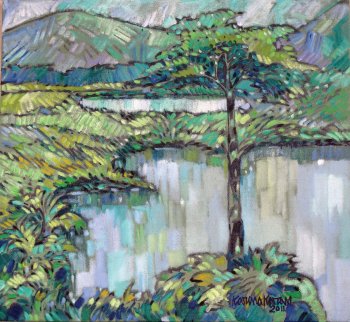 At the village library, he came across an article on KCS Panikkar and decided to go to Madras Art School, his destination. There, the boy of 12 without the basic schooling got enrolled thanks to the astute visionary, DP Roy Choudhari, the Principal. Although he chose Design as his subject, he discovered that his talent lay in Painting. Once again the authorities chose to help. "The Principal permitted me to attend the morning session in model drawing class with the painting students; designing classes in the afternoon." Later, as a part-time student at the Madras Museum, he entered the world of his love, painting. Art in independent India was in the grip of an identity crisis. It was trying to wriggle out of the influence of Victorian realist tradition. A conglomeration of regional traditions emerged. In Madras Art School, KCS Paniker introduced Impressionism and abstraction through his works. Even symbols from Tantric cult surfaced to create a new sensibility. Karunakaran began his creative pursuit in this milieu. The ideology of nativism and the philosophy of 'Art for Art sake' initiated by KCS had considerable influence on the artist growing up in the campus. He passed out as the best outgoing student winning a gold medal. But life was not easy for the young student. He painted seashells for sale. And he worked occasionally for the cinema industry in their studios. After an abortive attempt to complete formal schooling at home, he joined another course in 1959. During this period the company of talents like Viswanathan, Vasudevan, Santhanaraj, Muthukoya, Kanayi Kunhiraman, Namboodiri, TK Padmini et al was stimulating. "I recall how Padmini and I did a work jointly: my colours working with her powerful lines." 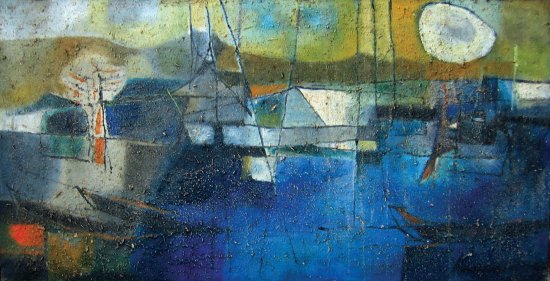 
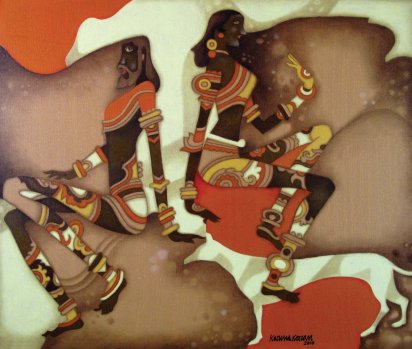 As an artist, CN began by painting landscapes. The style, of course was abstract. "I did landscapes only because I was afraid of doing figurative work." After his studies, he worked as a designer under K Sriniva¬sulu at the Government Demonstration Centre, Madras, to promote Indian Arts and Crafts. Srinivasulu was deeply inspired by Indian art traditions and helped to affirm the emergent views on Indian identity. "And that was the time when I gathered courage to become the figurative artist that I am today. It was this period that marked my coming of age into my own element." CN, the artist, blazed his own trail to enter the world of the figurative by sourcing the mural and miniature traditions. Kerala murals made a definitive impact on his sensibility enhancing his stylistics. KCS, the master, was trying to impress upon his students the need to evolve a visual vocabulary of their own to negotiate 'the local' within the discourse of the 'international.' KCS sent his students on compulsory trips that opened the gates of ancient Indian arts. CN came across the decorative aspect that he incorporated into his practice, as dominant feature of Bharatheeyatha. "The places that impacted me the most were Khajuraho. Halebid and Belur in Karnataka with their breathtaking ornamentation and attention to finely nuanced detail...I see ornamentation in art as a form of celebration." In 1970, Karunakaran got a chance to return to Kerala. Used to a life of hardships in Madras, it was homecoming even without many prospects. If Madras gave him the company of artists, Kochi ushered him into a think-tank that shaped the contours of the cultural map of Kerala in the seventies. His association with MV Devan, Kanayi Kunhiraman, ACK Raja, Namboodiri, and KP Soman were fruitful. Here, he began as an instructor in Kalapeetom and continued his art practice within the regional framework. At this institute, writers, thinkers, students and common people gathered for informal discussions on anything under the sun. MKK Nair, who was the patron of the institute, was a great inspiration for Karunakaran and others. CN Sreekantan Nair, MK Sanoo, Pattathuvila Karunakaran, M Thomas Mathew, TR, V Ramachandran, P Rajan, Prof. Ramachandran Nair et al frequented the place. Karunakaran was commissioned to restore the mural paintings of the Guruvayoor temple. In 1973 he opened Chithrakootam, his own art space in Kochi, the first of its kind in Kerala. Although short lived, the project liberated him to continue as a full-fledged artist. Quiet and unassuming by nature, his frail body houses an indomitable spirit. His life has been a venture with conviction and indomitable will. He dared to settle down in Kerala at a time when market for art was largely unknown, and dared to live by painting. Ever since, Karunakaran has retained his base in Kochi. And Kochi has developed as a metro with art as one of its facets. The recently launched book 'MYTHIC IMAGINATION: ART OF C.N. KARUNAKARAN' edited by Satyapal is a testimony to the singularity of his fine art. Quite handy, chronologically edited, the book is a visual odyssey through the 6 decades of his painting that traces the development of his art like a graph. The fine looking layout enhances the book like a work of art. His oeuvre is the transmutation of the eternal into a visual language with Indian sensibility. He has carved a niche for himself with his unique signature in visual arts. The book published in English language brings the artist to the national mainstream. The book is not just a collection of his works but a peep into the making of the artist and an assessment of his creative world by eminent writers in the field of art. 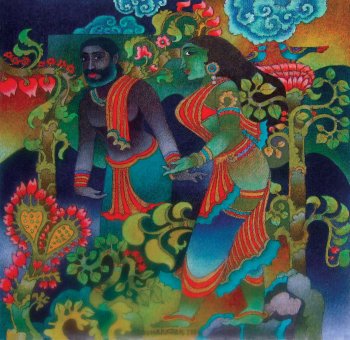
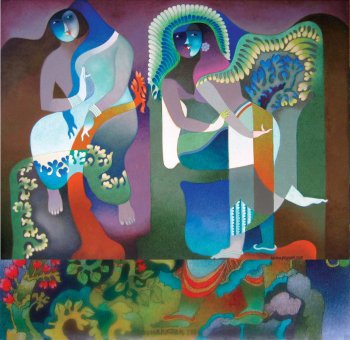 The creative world of the artist "Inhabited by gorgeous women, celestial men, marvelous birds and animals, and the exquisite forms of trees and foliage, CN Karunakaran's pictorial world embodies the human beings' desire to transcend the quotidian into the fantastical and divine," comments Johnny ML in his essay, 'The creative world of CN.' The streak of erotica that he adopted from miniatures with its spiritual connotations is a charming aspect of his humanscape set against nature, for nature survives in his works as an implicit norm. Kerala murals, miniatures and decorative forms in Indian art, classics in literature, traditional architecture, and folk forms orchestrate to create his visual symphony. "An important dimension conditioning his visual vocabulary is a quest for eternal beauty and feminine enchantment... Karunakaran's areas of subjective explora¬tion is centered on myths and nature, with women as his main protagonist," says Ashrafi Bhagat in her essay 'Mythic imagination: Paintings of CN Karunakaran.' P Sudhakaran in his 'Icons of feminine charm' affirms the same idea. CS Jayaram places the artist in perspective in the art scene of the times. CN's work does not forward a critique of social systems or life. Yet, the narrative is integral to the piece. It tells the story of the subtle drama of life: conflicting yin and yang in the persona of a human being. The hybrid beings presented in quasi abstract style reveal the animal, human and divine in a person or in personal relations. The viewer is invited to be a witness, very much like the artist himself present in the picture plane in the form of a creature. His technique His figurative style is versatile. It swings from geometric to organic and from figurative to quasi abstract. The line is powerful as in Kerala murals. The decorative is another adoption of the artist. "The umpteen traditional art styles that our country holds have plenty of inherent pristine beauty. The decorative style that I followed during much of my career was in¬fluenced by them," admits the artist in his interview by Radha Gomathy. And the decorative embellishment becomes part of his painting, which is structured, ordered and organized. The command of the line is the soul of the creative world of Karunakaran - be it paintings, drawings or literary illustrations. The theatricality of the facial expressions and gestures in his works reminds one of the folk arts of Kerala, like the Kalamezhuthu. He created his vocabulary through a process of re¬invention shaped by his modern sensibility. The familiar folk forms are transliterated with his signature style. "The famous 'two- dimensional' forms in striking rigid frontality, a minimum variation in gesture, and the replacement of individual likeness by canonic type, are the main features. Movement is arrested; the natural bulk of forms is flattened... all forms are gathered into a single plane; distance is eliminated in favor of ideal space; colours become pure, unmodulated, and the shadows vanish in the diffusion of an unremitting light to meta¬morphose into decorative patterns that ever remains a visual delight in his expressions." (Ashrafi Bhagat) 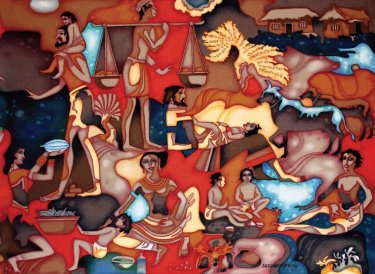 Karunakaran is a superb colourist, according to Vijayakumar Menon in his essay, 'The sensory palette of Karunakaran.' Flowing lines, sparkling hues and sober tones are naturally the vocabulary for creating the concept of feminine uniqueness of a musical quality. "His colours radiate into their own tonal gradations as in music. Whatever the colour he uses, the hue sinks into its lightest tones as a shadow or a reflection of it to get the silent repose of the same as the periodical absolute silence in reverberating musical compositions. Karunakaran's paintings have a kind of colour formula that shows the balance not of two different colours, but of tones of the same, each reflecting its own brightness or dullness. Transition of one hue from its freshness to its own numerous shades is musical as well as lyrical." Recent changes There has been a sea change in the feel of his work: in colouring, and a major shift in the treatment of figures. They are less schematic; stylized differently. The figures are elongated reminding one of Chola sculptures. The male gaze is muted. Theatricality is replaced by natural, hauntingly intense delineation. Even the depiction of the anatomy is more natural and soft. There is an entry of soft mellow tones - greys, salmon pinks, smoky purples, hints of raw umber. And there is a return to landscape as well. The recent body of his work has a certain quality of gentleness or mildness. "I must say, I stand by the Eastern no¬tion of the role and function of a work of art, that it must soothe, emit peacefulness and pleasantness from where it is placed," says the artist. Critiquing his oeuvre, Tanya Abraham says he has been known as "the untiring cartographer of female geography... the essence of the subject remains a constant, it is the flavor of the subject that moves to create and recreate". His engagement with the female is an aspect of his aesthetics. For the artist, lavanya is inbuilt in the female form. The aesthetic curves of her body and the way it carries ornamentation more naturally and culturally ensembles his picture plane. "Womanhood is a nurturing protective soothing, bliss-bestowing presence in Bharatheeyatha." If his oeuvre is the kaleidoscopic display of the same flakes, then what motivates the artist in his relentless pursuit? Human history records the quest towards the mystery of philosophers, of artists, of scientists and of adventurers. Maybe CN the artist too is engaged in his quest. Quite simply the artist says, "Painting for me is a continuous process. It is a ceaseless engagement with colour and form, with composition, arranging elements. It never ends, does it ...all the possible permutations and combinations. I paint to satisfy my own endless query canvas after canvas. I paint for my joy." An affirmation of life, like the celebration of something beautiful and peaceful. Karunakaran speaks at length about of his quest for 'Bharatheeyatha' with Gomathy in the interview. The cult of celebration is part of Bharatheeyatha. The peoples of the subcontinent, from tribes to mainstream societies, celebrate at the slightest provocation. And decoration and ornamentation is part of the mood of jubilation."Bharateeyatha for me is a quest of one's inner nature, an exposition of a lived experience, of interiority..." And the viewer is invited to share the artist's quest and his musings. If passing value judgments is not an obsession, it is a humbling experience at the portals of high art. Padma Jayaraj is a freelance writer and a regular contributor to www.narthaki.com Post your comments Please provide your name and email id along with your comment. All appropriate comments posted with name and email id in the blog will also be featured in the site. |